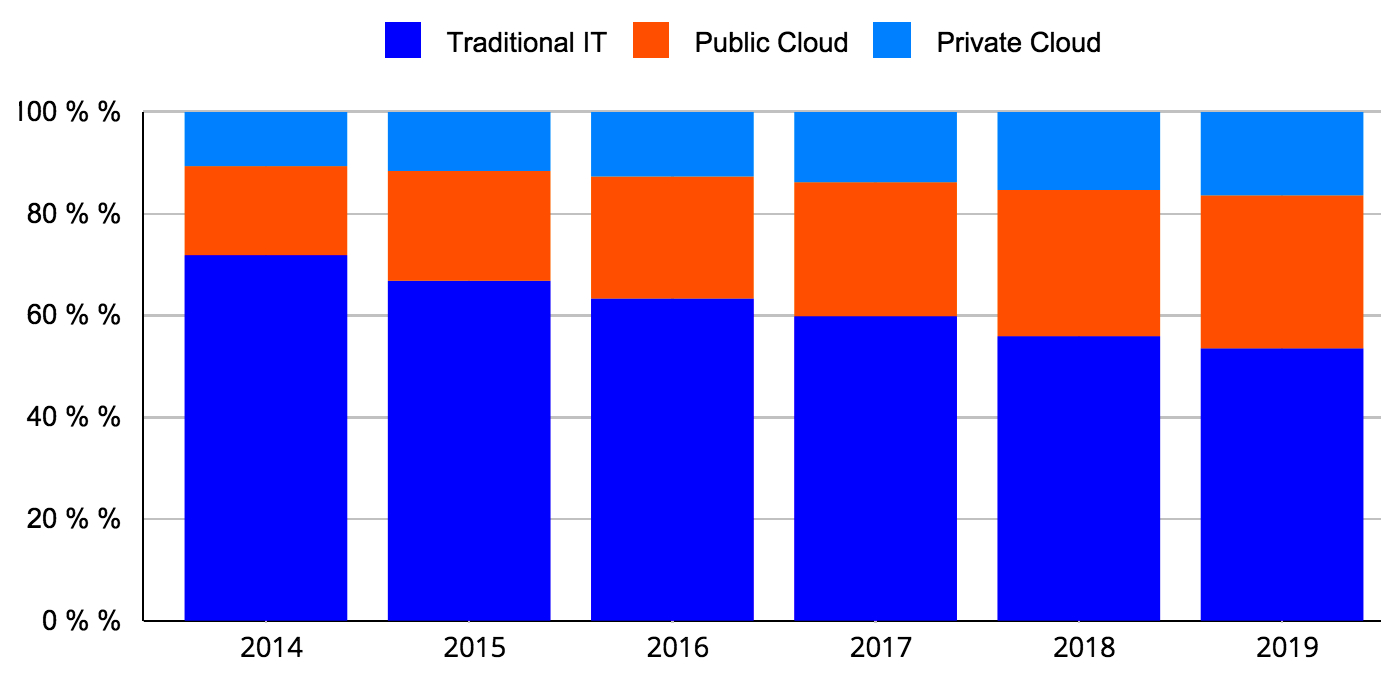WW Cloud IT Infrastructure Spending Forecast to Grow 26% in 2015 – IDC
CAGR of 15.6% to reach $54.6 billion by 2019
This is a Press Release edited by StorageNewsletter.com on July 14, 2015 at 3:11 pmAccording to the International Data Corporation‘s Worldwide Quarterly cloud IT Infrastructure Tracker, total cloud IT infrastructure spending (server, storage, and Ethernet switch) will grow by 26.4% in 2015 and will reach $33.4 billion, accounting for a third of all IT infrastructure spending, up from 28.1% in 2014.
Private cloud IT infrastructure spending will grow by 16.8% year over year to $11.7 billion, while public cloud IT infrastructure spending will grow by 32.2% in 2015 to $21.7 billion. In comparison, spending on non-cloud IT infrastructure will remain flat at $67 billion.
Worldwide Cloud IT Infrastructure Market Forecast
by Deployment Type – 2014-2019 (shares based on value)
IDC expects that spending on cloud IT infrastructure will grow across all regions and all technologies. In most regions, growth in public cloud IT infrastructure spending will exceed growth in spending on private cloud IT infrastructure as public cloud service providers will continue to invest in expansion of their datacenters and service offerings.
For the five-year forecast period, IDC expects that cloud IT infrastructure spending will grow at a CAGR of 15.6% and will reach $54.6 billion by 2019 accounting for 46.5% of the total spending on IT infrastructure.
At the same time, spending on non-cloud IT infrastructure will decline at a -1.4% CAGR. Spending on public cloud IT infrastructure will grow at a slightly higher rate than spending on private cloud IT infrastructure – at 16.5% vs 14% CAGR.
In 2019, IDC expects cloud service providers will spend $35.3 billion on IT infrastructure for delivering public cloud services, while spending on private cloud IT infrastructure will reach $19.2 billion.
“End users continue to evaluate various approaches to adopting cloud-based IT: some integrate public cloud service into their IT strategies, others choose to build their own private clouds or use third-party private cloud offerings, and some, seeing benefits in both, implement hybrid cloud strategies,” said Natalya Yezhkova, research director, storage systems. “The breadth and width of cloud offerings only continue to grow, with an increasing universe of business- and consumer-oriented solutions being born in the cloud and/or served better by the cloud. This growing demand from the end user side and expansion of cloud-based offerings from service providers will continue to fuel growth in spending on the underlying IT infrastructure in the foreseeable future.“
Taxonomy Notes:
IDC defines cloud services more formally through a checklist of key attributes that an offering must manifest to end users of the service. Public cloud services are shared among unrelated enterprises and consumers; open to,largely unrestricted universe of potential users; and designed for a market, not a single enterprise. The public cloud market includes variety of services designed to extend or, in some cases, replace IT infrastructure deployed in corporate datacenters. It also includes content services delivered by a group of suppliers IDC calls Value Added Content Providers (VACP). Private cloud services are shared within a single enterprise or an extended enterprise with restrictions on access and level of resource dedication and dfined/controlled by the enterprise (an beyond the control available in public cloud offerings); can be onsite or offsite; and can be managed by a third-party or in-house staff. In private cloud that is managed by in-house staff, ‘vendors (cloud service providers)’ are equivalent to the IT departments/shared service departments within enterprises/groups. In this utilization model, where standardized services are jointly used within the enterprise/group, business departments, offices, and employees are the ‘service users.’













 Subscribe to our free daily newsletter
Subscribe to our free daily newsletter

